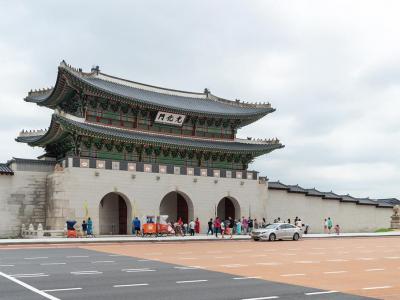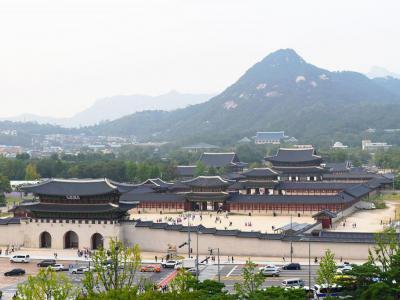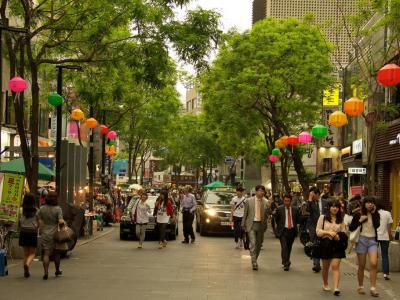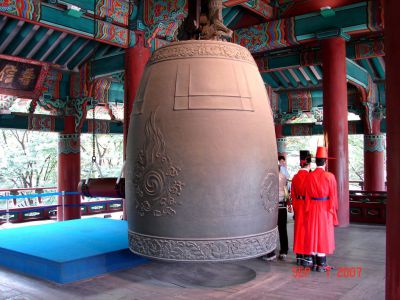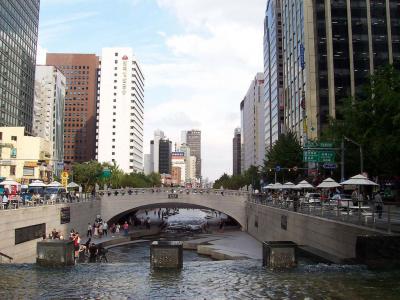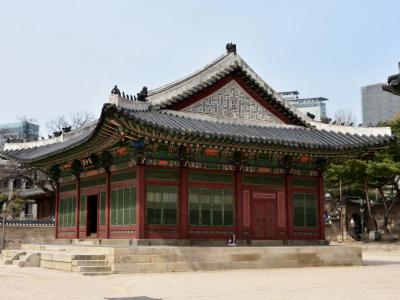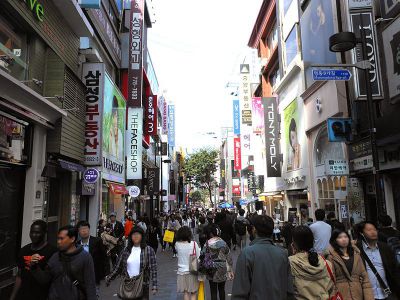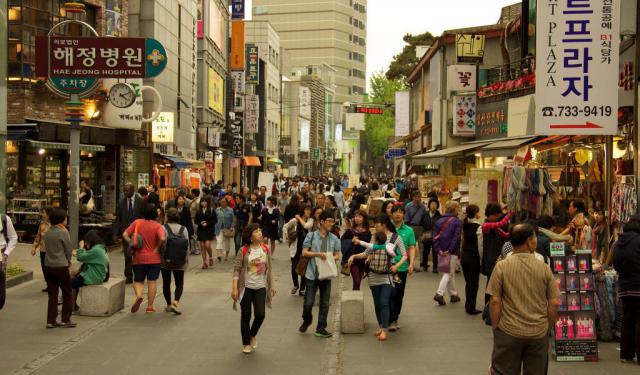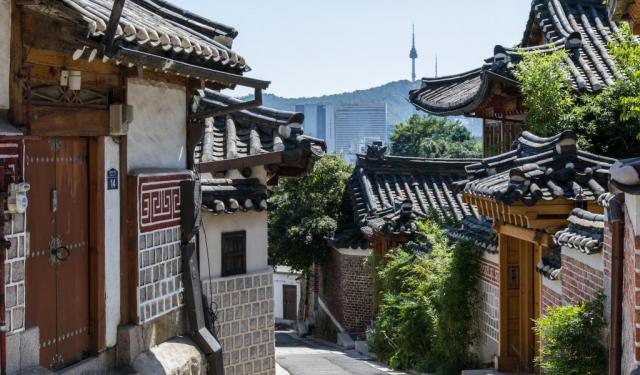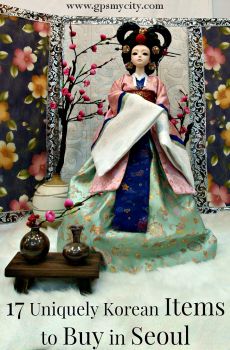Seoul Introduction Walking Tour (Self Guided), Seoul
The bustling capital of South Korea, Seoul, seamlessly blends modern innovation with a more than 2,000-year history. Remarkably, until 1972, the city was claimed by North Korea as its de jure capital and even specified as such in its constitution.
Seoul was founded in 18 BC by the people of Baekje. The three ancient kingdoms of Korea – Baekje, Goguryeo, and Silla – fought over its possession due to the strategic location along the Han River. After the Joseon Dynasty came to power in 1392, the city was declared their capital and surrounded by the Fortress Wall.
Throughout the centuries, Seoul has been known by several names including Hwangseong, which means "the imperial city," after the proclamation of the Korean Empire in 1897.
During the Japanese annexation of Korea in the early 20th century, it was renamed Keijo and saw significant transformation. Imperial Japan removed the city walls, paved roads, and built Western-style buildings. Simultaneously, Seoul was reduced in status and size, shrinking roughly to the Fortress Wall area.
After the liberation of Korea by US forces at the end of World War II, the city took its present name, which originated from the ancient Korean word "Seorabeol," meaning "capital city".
During the Korean War of the 1950s, Seoul changed hands four times between the Soviet/Chinese-backed North Korean and the American-backed South Korean forces. The fierce fighting left the city in ruins and caused a flood of refugees.
However, reconstruction and modernization following the war turned Seoul into one of the highest, most interesting, and cleanest cities in the East. In the 1960s, the city went through major expansions, establishing its present-day shape and size.
Acquaintance with present-day Seoul is best done at Myong-dong Street where high-end fashion, skyscrapers, electronics stores, and street food stalls are in abundance, delighting those eager to shop and eat till they drop.
To discover some of the hidden treasures, you will have to explore the back alleys of Insa-dong. Also, you would certainly want to see the changing of the Royal Guards' ceremony at the Gwanghwamun Gate and set aside time to explore both the Gyeongbokgung and Deoksugung Palaces.
As you immerse yourself in the sights, sounds, and flavors of Seoul, you'll discover a fascinating juxtaposition that effortlessly marries rich cultural heritage with modern allure. To appreciate contemporary Seoul's vibrant culture in its entirety and to see the city's top attractions, both ancient and new, take this self-guided walking tour!
Seoul was founded in 18 BC by the people of Baekje. The three ancient kingdoms of Korea – Baekje, Goguryeo, and Silla – fought over its possession due to the strategic location along the Han River. After the Joseon Dynasty came to power in 1392, the city was declared their capital and surrounded by the Fortress Wall.
Throughout the centuries, Seoul has been known by several names including Hwangseong, which means "the imperial city," after the proclamation of the Korean Empire in 1897.
During the Japanese annexation of Korea in the early 20th century, it was renamed Keijo and saw significant transformation. Imperial Japan removed the city walls, paved roads, and built Western-style buildings. Simultaneously, Seoul was reduced in status and size, shrinking roughly to the Fortress Wall area.
After the liberation of Korea by US forces at the end of World War II, the city took its present name, which originated from the ancient Korean word "Seorabeol," meaning "capital city".
During the Korean War of the 1950s, Seoul changed hands four times between the Soviet/Chinese-backed North Korean and the American-backed South Korean forces. The fierce fighting left the city in ruins and caused a flood of refugees.
However, reconstruction and modernization following the war turned Seoul into one of the highest, most interesting, and cleanest cities in the East. In the 1960s, the city went through major expansions, establishing its present-day shape and size.
Acquaintance with present-day Seoul is best done at Myong-dong Street where high-end fashion, skyscrapers, electronics stores, and street food stalls are in abundance, delighting those eager to shop and eat till they drop.
To discover some of the hidden treasures, you will have to explore the back alleys of Insa-dong. Also, you would certainly want to see the changing of the Royal Guards' ceremony at the Gwanghwamun Gate and set aside time to explore both the Gyeongbokgung and Deoksugung Palaces.
As you immerse yourself in the sights, sounds, and flavors of Seoul, you'll discover a fascinating juxtaposition that effortlessly marries rich cultural heritage with modern allure. To appreciate contemporary Seoul's vibrant culture in its entirety and to see the city's top attractions, both ancient and new, take this self-guided walking tour!
How it works: Download the app "GPSmyCity: Walks in 1K+ Cities" from Apple App Store or Google Play Store to your mobile phone or tablet. The app turns your mobile device into a personal tour guide and its built-in GPS navigation functions guide you from one tour stop to next. The app works offline, so no data plan is needed when traveling abroad.
Seoul Introduction Walking Tour Map
Guide Name: Seoul Introduction Walking Tour
Guide Location: South Korea » Seoul (See other walking tours in Seoul)
Guide Type: Self-guided Walking Tour (Sightseeing)
# of Attractions: 7
Tour Duration: 2 Hour(s)
Travel Distance: 3.5 Km or 2.2 Miles
Author: vickyc
Sight(s) Featured in This Guide:
Guide Location: South Korea » Seoul (See other walking tours in Seoul)
Guide Type: Self-guided Walking Tour (Sightseeing)
# of Attractions: 7
Tour Duration: 2 Hour(s)
Travel Distance: 3.5 Km or 2.2 Miles
Author: vickyc
Sight(s) Featured in This Guide:
- Gwanghwamun Gate
- Gyeongbokgung Palace
- Insadong Shopping Street
- Bosingak Pavilion
- Cheonggye Plaza and Stream
- Deoksugung Palace
- Myong-dong Shopping Street
1) Gwanghwamun Gate
Gwanghwamun Gate is main entrance into Gyeongbokgung Palace, and so it is also the largest and most imposing of the four gates. It features three grand arched gates--the center gate was reserved for use by the king, while the crown prince and royal officials used the other two smaller arches.
The tall granite structure of the gate supports the ornately decorated wooden gate tower, which watches over the city. The pavilon housed a bell that announced the time of the day to the city. Two majestic Haetae sculptures guard the gate. These mythical lion-like beasts were stationed there to protect the palace against fire.
Gwanghwamun Gate was one of only four gates constructed in the palace walls. They were originally constructed in 1395 during the reign of King Taejo of the Joseon Dynasty. But the gates and walls have been through many cycles of destruction and reconstruction.
It was destroyed by fire during the Imjin Wars in 1592 and laid in ruins until it was rebuilt in 1867. In 1926, the Japanese government moved Gwanghwamun Gate. The double-roofed wooden pavilion on the gate was destroyed during the Korean War. The gate was moved again in 1968.
Gwanghwamun Gate was moved back to its original location in 2006, and the restoration was completed in 2010. The restoration included recreating the base with traditional materials, recreating the original wooden pavilion structure with Korean pine, and recreating the wooden nameplate.
The area in front of Gwanghwamun Gate is known as Gwanghwamun Plaza. Here, visitors can watch the impressive royal changing of the guard ceremony. This ceremony is held daily, every hour, on the hour, from 10:00 to 15:00.
Tip:
The square housing the gate contains fountains, statues and sculptures that are also definitely worth seeing, plus an underground museum dedicated to Sejong the Great, the 4th king of the Joseon Dynasty.
The tall granite structure of the gate supports the ornately decorated wooden gate tower, which watches over the city. The pavilon housed a bell that announced the time of the day to the city. Two majestic Haetae sculptures guard the gate. These mythical lion-like beasts were stationed there to protect the palace against fire.
Gwanghwamun Gate was one of only four gates constructed in the palace walls. They were originally constructed in 1395 during the reign of King Taejo of the Joseon Dynasty. But the gates and walls have been through many cycles of destruction and reconstruction.
It was destroyed by fire during the Imjin Wars in 1592 and laid in ruins until it was rebuilt in 1867. In 1926, the Japanese government moved Gwanghwamun Gate. The double-roofed wooden pavilion on the gate was destroyed during the Korean War. The gate was moved again in 1968.
Gwanghwamun Gate was moved back to its original location in 2006, and the restoration was completed in 2010. The restoration included recreating the base with traditional materials, recreating the original wooden pavilion structure with Korean pine, and recreating the wooden nameplate.
The area in front of Gwanghwamun Gate is known as Gwanghwamun Plaza. Here, visitors can watch the impressive royal changing of the guard ceremony. This ceremony is held daily, every hour, on the hour, from 10:00 to 15:00.
Tip:
The square housing the gate contains fountains, statues and sculptures that are also definitely worth seeing, plus an underground museum dedicated to Sejong the Great, the 4th king of the Joseon Dynasty.
2) Gyeongbokgung Palace (must see)
Gyeongbokgung Palace was built in 1395 by the Joseon Dynasty. This impressive complex served as the Joseon Dynasty's main palace and is the largest of the Five Grand Palaces.
It was destroyed by fire during the Imjin War in 1592 and sat abandoned for over two centuries. In 1867, the palace was reconstructed with 330 buildings and 5,792 rooms. In 1895, Japanese agents assassinated Empress Myeongseong. Emperor Gojong, her husband, left the palace and never returned.
In the early 20th century, Japan's colonial government destroyed palace buildings and constructed the enormous Japanese General Government Building outside the throne hall.
Only a few 19th-century buildings survived the Japanese government and the Korean War. These buildings include Geunjeongjeon (the Imperial Throne Hall), Hyangwonjeong Pavilion, Gyeonghoeru Pavilion, Sujeongjeon Hall, Jagyeongjeon Hall, Sajeongjeon Hall, and Jibokjae Hall.
In 1989, reconstruction began to restore the palace to its former glory. About 40 percent of the building have since been reconstructed or restored.
Geunjeongjeon, the Imperial Throne Hall, is truly impressive. Its constructed mainly of wood and sits in a courtyard lined with stones. Known as rank stones, they indicated where officials of different ranks could stand during ceremonies. The entire courtyard is cloistered.
Gyeongbokgung Palace features dozens of architecturally interesting buildings. Hyangwonjeong, a beautiful hexagonal pavilion, sits attractively on an island.
Why You Should Visit:
Gyeongbokgung Palace is the largest and grandest of the Five Grand Palaces. Visit the National Folk Museum of Korea on the palace grounds to learn about the history of the Korean people. The National Palace Museum of Korea is also located on the palace grounds and houses priceless 14th century Joseon dynasty treasures.
Tips:
You can rent traditional costumes to immerse yourself in 14th-century royal Korea.
For a memorable experience, sign up for a night tour and see the palace lit up. Gyeonghoeru looks spectacular as its warm lights are reflected in the pond.
For a once in a lifetime experience, take part in a Gyeongbokgung Royal Dining event. Sample royal food and watch a traditional performance.
It was destroyed by fire during the Imjin War in 1592 and sat abandoned for over two centuries. In 1867, the palace was reconstructed with 330 buildings and 5,792 rooms. In 1895, Japanese agents assassinated Empress Myeongseong. Emperor Gojong, her husband, left the palace and never returned.
In the early 20th century, Japan's colonial government destroyed palace buildings and constructed the enormous Japanese General Government Building outside the throne hall.
Only a few 19th-century buildings survived the Japanese government and the Korean War. These buildings include Geunjeongjeon (the Imperial Throne Hall), Hyangwonjeong Pavilion, Gyeonghoeru Pavilion, Sujeongjeon Hall, Jagyeongjeon Hall, Sajeongjeon Hall, and Jibokjae Hall.
In 1989, reconstruction began to restore the palace to its former glory. About 40 percent of the building have since been reconstructed or restored.
Geunjeongjeon, the Imperial Throne Hall, is truly impressive. Its constructed mainly of wood and sits in a courtyard lined with stones. Known as rank stones, they indicated where officials of different ranks could stand during ceremonies. The entire courtyard is cloistered.
Gyeongbokgung Palace features dozens of architecturally interesting buildings. Hyangwonjeong, a beautiful hexagonal pavilion, sits attractively on an island.
Why You Should Visit:
Gyeongbokgung Palace is the largest and grandest of the Five Grand Palaces. Visit the National Folk Museum of Korea on the palace grounds to learn about the history of the Korean people. The National Palace Museum of Korea is also located on the palace grounds and houses priceless 14th century Joseon dynasty treasures.
Tips:
You can rent traditional costumes to immerse yourself in 14th-century royal Korea.
For a memorable experience, sign up for a night tour and see the palace lit up. Gyeonghoeru looks spectacular as its warm lights are reflected in the pond.
For a once in a lifetime experience, take part in a Gyeongbokgung Royal Dining event. Sample royal food and watch a traditional performance.
3) Insadong Shopping Street (must see)
The abundance of wooden tea houses (nearly 40), boutique galleries and street vendors offering traditional Korean snacks makes Insa-dong street in Seoul a true magnet for visitors of the Korean capital. Alongside the free entertainment the area is famous for, Insa-dong is also one of the key destinations in the city for buying traditional Korean art, products and souvenirs, such as hanbok (traditional clothing), hanji (traditional paper), traditional teas, pottery, and folk crafts.
There is a plethora of antique shops (more than 50), art galleries (80+), traditional stationery shops, handicraft shops, pottery and porcelain shops, bookstores, and art supply stores. On top of that, there are almost 100 restaurants specialized in traditional Korean cuisine. With such a variety on offer, one is really bound to be spoilt for choice here.
On Sundays the street turns pedestrian-only and is flooded with street performers, buskers and the lively crowds of young and old rushing to enjoy one of Seoul’s most exiting and creative neighborhoods. The tastefully decorated traditional teashops invite passers-by to relax in a calm zen-like atmosphere. For those interested in Korean traditional culture and crafts, Insa-dong is undoubtedly a must-see attraction which will leave imprint of Seoul in one's memory for the years to come.
There is a plethora of antique shops (more than 50), art galleries (80+), traditional stationery shops, handicraft shops, pottery and porcelain shops, bookstores, and art supply stores. On top of that, there are almost 100 restaurants specialized in traditional Korean cuisine. With such a variety on offer, one is really bound to be spoilt for choice here.
On Sundays the street turns pedestrian-only and is flooded with street performers, buskers and the lively crowds of young and old rushing to enjoy one of Seoul’s most exiting and creative neighborhoods. The tastefully decorated traditional teashops invite passers-by to relax in a calm zen-like atmosphere. For those interested in Korean traditional culture and crafts, Insa-dong is undoubtedly a must-see attraction which will leave imprint of Seoul in one's memory for the years to come.
4) Bosingak Pavilion
Bosingak Pavilion is a historic bell pavilion that gave its name to the surrounding district of Jongno, which translates to “Bell Street” in reference to the pavilion’s original function. Originally constructed in 1396 during the Joseon Dynasty, Bosingak has been rebuilt multiple times across centuries, most recently in 1979. The original 1468 bronze bell is now housed at the National Museum of Korea, while a faithful modern replica takes its place today.
This pavilion once served as Seoul’s public clock: during the Joseon era, the bell was struck to signal the opening of the city gates at 4 am and closing at 10 pm, with 33 tolls marking each event. It also functioned as a fire and danger alarm for residents. Today, the bell is rung only on special occasions, most notably at midnight on New Year’s Eve, when crowds gather to hear its powerful 33 strikes ushering in the next year in a cherished city-wide tradition.
Beyond New Year’s Eve, visitors can occasionally experience a bell ringing at noon-an echo of its former role in keeping time for the entire city. While entry into the pavilion interior is generally restricted, the ornate two-tiered wooden structure-with elegant dancheong painted patterns and a raised platform-offers a contrast set against modern high-rises.
This pavilion once served as Seoul’s public clock: during the Joseon era, the bell was struck to signal the opening of the city gates at 4 am and closing at 10 pm, with 33 tolls marking each event. It also functioned as a fire and danger alarm for residents. Today, the bell is rung only on special occasions, most notably at midnight on New Year’s Eve, when crowds gather to hear its powerful 33 strikes ushering in the next year in a cherished city-wide tradition.
Beyond New Year’s Eve, visitors can occasionally experience a bell ringing at noon-an echo of its former role in keeping time for the entire city. While entry into the pavilion interior is generally restricted, the ornate two-tiered wooden structure-with elegant dancheong painted patterns and a raised platform-offers a contrast set against modern high-rises.
5) Cheonggye Plaza and Stream (must see)
Cheonggyecheon Stream flows through downtown Seoul. The stream was covered up with concrete for many decades. In 2003, work to remove the elevated highway and restore the stream began. The stream was officially re-opened in 2005.
The stream runs under 22 bridges and flows into the Hangang River. Gwangtonggyo Bridge was one of the busiest and most important bridges of the Joseon Dynasty. It was also buried for 100 years during Seoul's economic boom. Now restored, it's one of the most scenic places on the Cheonggyecheon Stream.
Cheonggye Plaza is located at the head of Cheonggyecheon Stream. The plaza celebrates the re-opening of the stream. The vibrant red and blue Spring Sculpture dominates the plaza. The sculpture's design is reminiscent of a shell rising like a pagoda. The colorful ribbons represent traditional Korean wrapping cloth known as a bojagi.
The Candlelight Fountain at the plaza is a stunning two-tiered, four-meter (13-foot) tall waterfall. It's stunning at night when the lights of Seoul are reflected in the water.
The stream runs under 22 bridges and flows into the Hangang River. Gwangtonggyo Bridge was one of the busiest and most important bridges of the Joseon Dynasty. It was also buried for 100 years during Seoul's economic boom. Now restored, it's one of the most scenic places on the Cheonggyecheon Stream.
Cheonggye Plaza is located at the head of Cheonggyecheon Stream. The plaza celebrates the re-opening of the stream. The vibrant red and blue Spring Sculpture dominates the plaza. The sculpture's design is reminiscent of a shell rising like a pagoda. The colorful ribbons represent traditional Korean wrapping cloth known as a bojagi.
The Candlelight Fountain at the plaza is a stunning two-tiered, four-meter (13-foot) tall waterfall. It's stunning at night when the lights of Seoul are reflected in the water.
6) Deoksugung Palace
Deoksugung Palace is the smallest of the Five Grand Palaces built by the Joseon Dynasty. This residence became a royal palace after the other palaces burned in 1592. King Gwanghaegun and King Injo were crowned in Jeukjodang Hall in the 1600s.
Deoksugung Palace was heavily damaged during colonial rule. The palace is now only about one-third of its original size. Hamnyeongjeon Hall was the sleeping residence for King Gojong after he moved to the palace in 1897.
Deoksugung Palace has many interesting architectural features. It includes buildings made from stucco, stone, and wood with architectural style blend eastern and western designs. Visitors will also find a beautiful western-style garden and fountain.
The neoclassical Seokjojeon Hall was built in 1910. With its triangular roof and tall collonades, this building is a striking departure from traditional Korean architecture. The Daehan Empire History Museum is located inside Seokjojeon Hall.
Jeonggwanheon, built around 1910, combines eastern and western styles. Kings in the Joseon Dynasty had their portraits enshrined here.
Don't miss the colorful changing of the guard outside Daehanmun Gate.
Why You Should Visit:
This is the only palace in Seoul where you can take photos with the Royal Guards after the changing ceremony. Unlike other palaces, you can also enter the grounds at night to enjoy a moonlit stroll. Beyond the palace, you can explore the historic neighborhood and the famous Stonewall Walkway along the palace walls.
Tip:
Going inside the castle, you'll need to pay a fee, unless you're wearing a 'hanbik' – then it's free!
Make sure you check out the Jeongdong Observatory, located next door to the palace. From the observation deck (18th floor) you can capture panoramic views of the Deoksugung Palace grounds, CBD skyline, City Hall grounds and other landmarks – and its free! You'll get some amazing photos as a souvenir.
Deoksugung Palace was heavily damaged during colonial rule. The palace is now only about one-third of its original size. Hamnyeongjeon Hall was the sleeping residence for King Gojong after he moved to the palace in 1897.
Deoksugung Palace has many interesting architectural features. It includes buildings made from stucco, stone, and wood with architectural style blend eastern and western designs. Visitors will also find a beautiful western-style garden and fountain.
The neoclassical Seokjojeon Hall was built in 1910. With its triangular roof and tall collonades, this building is a striking departure from traditional Korean architecture. The Daehan Empire History Museum is located inside Seokjojeon Hall.
Jeonggwanheon, built around 1910, combines eastern and western styles. Kings in the Joseon Dynasty had their portraits enshrined here.
Don't miss the colorful changing of the guard outside Daehanmun Gate.
Why You Should Visit:
This is the only palace in Seoul where you can take photos with the Royal Guards after the changing ceremony. Unlike other palaces, you can also enter the grounds at night to enjoy a moonlit stroll. Beyond the palace, you can explore the historic neighborhood and the famous Stonewall Walkway along the palace walls.
Tip:
Going inside the castle, you'll need to pay a fee, unless you're wearing a 'hanbik' – then it's free!
Make sure you check out the Jeongdong Observatory, located next door to the palace. From the observation deck (18th floor) you can capture panoramic views of the Deoksugung Palace grounds, CBD skyline, City Hall grounds and other landmarks – and its free! You'll get some amazing photos as a souvenir.
7) Myong-dong Shopping Street (must see)
Myeongdong is Korea's best-known shopping district. You will find mid-priced malls, high-end flagship stores, Korean brands, and international designer brands. Add in a smorgasbord of street food, cafes, restaurants, and night-life, and you have an exciting destination that will leave you dazzled.
During the Joseon Dynasty, this was a residential area. It became more commercial during the Japanese era. As the economy boomed after the Korean War, this area became the extensive shopping center that it is today. It's consistently named as one of the most expensive shopping districts in the world.
Myeongdong Shopping Street has every brand and item you could want. Shop international brands such as Polo Ralph Lauren and Louis Vuitton. Popular Korean cosmetic brands include Missha and The Face Shop. There are hotels, restaurants, cinemas, and theaters to keep you entertained.
Lotte Department Store, a Korean brand, is an impressive 14 stories tall. It features western styles as well as traditional Korean goods and has a food court.
If the weather is getting you down, keep going down to the Myeongdong Underground Shopping Center. The prices go down too--you'll find discount brands, cosmetics, and salons.
The Myeongdong Festival is held twice a year, in spring and autumn. Parades, live music, dance performances, and fashion shows are sure to impress.
Myeongdong Cathedral is a Catholic church that was dedicated in 1898. This beautiful church features a 45-meter steeple and ornate stained-glass windows.
Why You Should Visit:
Myeongdong is the shopping mecca of Seoul. Come during the day for retail therapy. At night, enjoy the city night-life and street food.
Tips:
Visit in the evening and try as much street food as you can devour. You'll find savory chicken, spicy options, and an array of desserts.
During the Joseon Dynasty, this was a residential area. It became more commercial during the Japanese era. As the economy boomed after the Korean War, this area became the extensive shopping center that it is today. It's consistently named as one of the most expensive shopping districts in the world.
Myeongdong Shopping Street has every brand and item you could want. Shop international brands such as Polo Ralph Lauren and Louis Vuitton. Popular Korean cosmetic brands include Missha and The Face Shop. There are hotels, restaurants, cinemas, and theaters to keep you entertained.
Lotte Department Store, a Korean brand, is an impressive 14 stories tall. It features western styles as well as traditional Korean goods and has a food court.
If the weather is getting you down, keep going down to the Myeongdong Underground Shopping Center. The prices go down too--you'll find discount brands, cosmetics, and salons.
The Myeongdong Festival is held twice a year, in spring and autumn. Parades, live music, dance performances, and fashion shows are sure to impress.
Myeongdong Cathedral is a Catholic church that was dedicated in 1898. This beautiful church features a 45-meter steeple and ornate stained-glass windows.
Why You Should Visit:
Myeongdong is the shopping mecca of Seoul. Come during the day for retail therapy. At night, enjoy the city night-life and street food.
Tips:
Visit in the evening and try as much street food as you can devour. You'll find savory chicken, spicy options, and an array of desserts.
Walking Tours in Seoul, South Korea
Create Your Own Walk in Seoul
Creating your own self-guided walk in Seoul is easy and fun. Choose the city attractions that you want to see and a walk route map will be created just for you. You can even set your hotel as the start point of the walk.
Insa-dong Walking Tour
Originating 500 years ago as a residential quarter for government officials, today's Insa-dong is a buzzing shopping and dining district in Seoul where the past meets the present. During the Japanese occupation of the country in the first half of the 20th century, wealthy Koreans were forced to move out and sell their belongings, at which point the district became a center of antique trading.... view more
Tour Duration: 1 Hour(s)
Travel Distance: 0.8 Km or 0.5 Miles
Tour Duration: 1 Hour(s)
Travel Distance: 0.8 Km or 0.5 Miles
Bukchon Hanok Village Walk
Bukchon Hanok, the traditional Korean village in downtown Seoul, is famous for its well-preserved 600-year-old setting. Once home to the nation’s nobility, the village sits on a hill near the Changdeokgung Palace.
One notable attraction here is Baek In-je's House Museum, which provides insight into the life of a prominent Korean politician from the early 20th century. Meanwhile, the... view more
Tour Duration: 1 Hour(s)
Travel Distance: 1.7 Km or 1.1 Miles
One notable attraction here is Baek In-je's House Museum, which provides insight into the life of a prominent Korean politician from the early 20th century. Meanwhile, the... view more
Tour Duration: 1 Hour(s)
Travel Distance: 1.7 Km or 1.1 Miles
Useful Travel Guides for Planning Your Trip
17 Uniquely Korean Souvenirs to Buy in Seoul
Back in the mid 20th century, a certain gentleman once spoke of Korea saying, it won't be possible to grow a rose in a waste bin. Certainly, one would hardly subscribe to his point of view today in every respect, given the image of contemporary South Korea and its capital city of Seoul in...
The Most Popular Cities
/ view all



